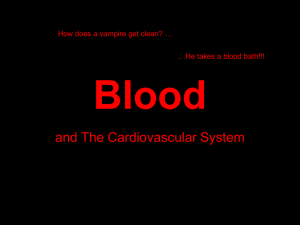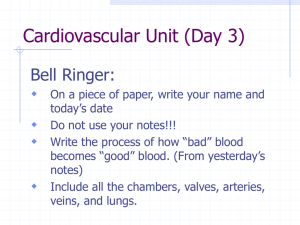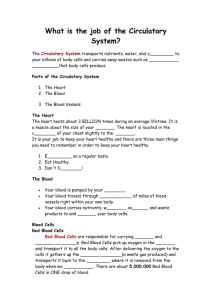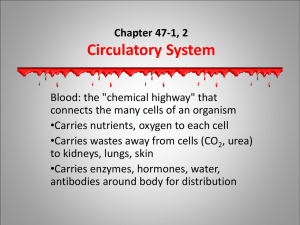Anatomy_and_Physiology_files/Blood and cardio
advertisement
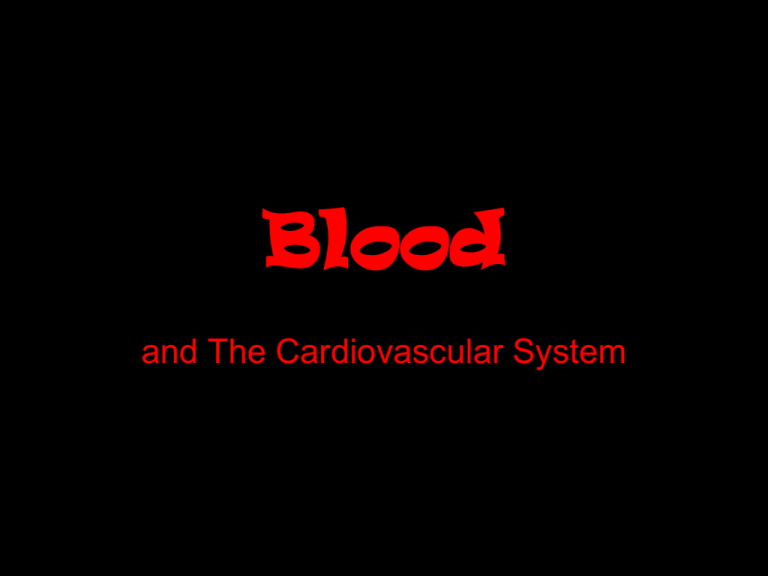
Blood and The Cardiovascular System Volume and Composition Average human adult has a blood volume of about 5.3 liters. Sample of blood = 45% cells by volume – called Hematocrit (HCT) or Packed Cell Volume (PCV) Types of CellsRed Blood Cells White Blood Cells Platelets Volume and Composition Other 55% is a clear, straw colored liquid called plasma. Plasma components: Water Proteins Amino Acids Nutrients Electrolytes Wastes Red Blood Cells Also called Erythrocytes Biconcave Shape –Thin in the middle and thick on the outside. Why might these be shaped in this way? Reason #1 – Increases surface area, assisting in transportation of gases Reason #2 - places the membrane closer to oxygen-carrying hemoglobin in the cell. Reason #3 – Shape allows it to squeeze through the tiny capillaries. Red Blood Cells What is hemoglobin? A molecule in red blood cells that transports oxygen. It is responsible for the red color of red blood cells Equals about 1/3 of each RBC by volume With Oxygen it is oxyhemoglobin and a very bright red. Without Oxygen it is deoxyhemoglobin and a darker red White Blood Cells • Also known as Leukocytes • Primary Function = fight disease and infection • Two groups – Granulocytes – granules in cytoplasm • Short life spans, mainly in blood – Agranulocytes – no granules in cytoplasm • Longer life spans, can leave bloodstream Platelets • Also called Thrombocytes – Not necessarily Red Blood Cell fragments – Arise from Megakaryocytes • These fragment, releasing small sections into cytoplasm – Each platelet: • Half the size of a RBC • Lack a nucleus • Function in the formation of blood clots • Break up and review three types of cells and their functions. Plasma • • • • • • 92% Water Functions 1. Transport materials 2. Regulate Fluid and electrolyte levels 3. Regulate pH Components – Plasma proteins – Nutrients and Gases – Plasma Electrolytes Plasma Proteins • 3 Types • Albumins – Smallest in Size, make up 60% of volume – Function – Osmotic Pressure – Why are so many needed? • Globulins – Alpha and Beta – transport lipids and vitamins – Gamma – are a type of antibody • Fibrinogen – Least common plasma protein (4%) – Function – Blood Coagulation Nutrients and Gases • • • • Includes amino acids, simple sugars, and lipids Where do these nutrients come from? How are lipids able to be in the plasma? Lipoproteins – Low density Lipoproteins • Bad Cholesterol (LDL) • Why bad? – High Density Lipoproteins • Good Cholesterol (HDL) • Why good? • How do they have different densities? Plasma Electrolytes • Plasma Electrolytes • Include: Sodium, Potassium, Calcium, Chloride, and others • Where do they come from? • Purposes: • 1. Maintain Osmotic Pressure • 2. Supply tissues with electrolytes when needed • 3. Regulate pH Production of a Blood Cell • • • • • • Occurs in the red bone marrow All types start out as a Hemocytoblast Platelets then become what? Megakaryocytes, which break apart WBCs become leukocytes, many diff. types RBCs • Use a negative feedback system – means what? • Low oxygen = more erythropoietin – More oxygen = less erythropoietin • Become erythrocytes Blood Clotting • Hemostasis – stoppage of bleeding • Done in three ways • 1. Vasospasm – What is this? • Muscular layers in the walls of the vessel contract – Can sometimes close the vessel completely – May only last for a few minutes Hemostasis • 2. Platelet plug – What is this? • Platelets stick to any rough surface, to collagen, and to eachother • When a break occurs, they stick to the vessel, then to each other – This keeps building, creates a dam. – Fig. 12.12 on page 333 Hemostasis • • • • 3. Blood Coagulation What is this? Formation of a blood clot This is the most effective, but also most complex way • Many things must occur for this to happen – Prothrombin to thrombin – Fibrinogen to Fibrin – Positive feedback system Blood Coagulation • What must happen? Parts of the heart • External Anatomy • Covered with the Pericardium – A sac like structure filled with fluid surrounding the heart. – Why would this be here? • Used mainly for protection • Walls of the heart are thick and muscular – Why would this be? Parts of the heart • • • • Internal Anatomy 4 Chambers Atria – Blood enters heart here – From where? • Body or the lungs • Ventricles – Blood leaves heart from here – The walls are much thicker around the ventricles, why? Parts of the heart • Atria and Ventricles separated by valves. • What are they going to do? • They prevent blood from flowing the wrong direction • Tricuspid valve – between right atrium and right ventricle • Bicuspid valve – between left atrium and left ventricle • Also valves at the beginning of pulmonary veins and aorta Path of Blood • Right atrium Right ventricle pulmonary artery lungs pulmonary vein left atrium left ventricle aorta body vena cava right atrium Blood Vessels • • • • • 3 types Arteries Veins Capillaries All of these provide a closed system for blood to continuously flow through – But each are structurally and functionally different. Blood Vessels • Arteries • Carry blood away from the heart at high pressures • Characteristics of the walls: – Strong – Thick – Elastic • Why would the walls have these characteristics? Blood Vessels • • • • Veins Designed to carry blood back to the heart. Run parallel to arteries Wall is similar in structure to arteries, but muscular layer is less developed. – Wall is thinner, weaker, and less elastic Blood Vessels • Capillaries • Smallest of blood vessels – Some are so small that only a single RBC can make it through at a time • Have extremely thin walls • Why would they have such thin walls? • This is the point where gases and nutrients are exchanged. Not sure what this is !?! Red Blood Cells Erythrocytes Have Sample of blood = 45% cells by volume – called Hematocrit (HCT) Types of CellsRed Blood Cells White Blood Cells Platelets


